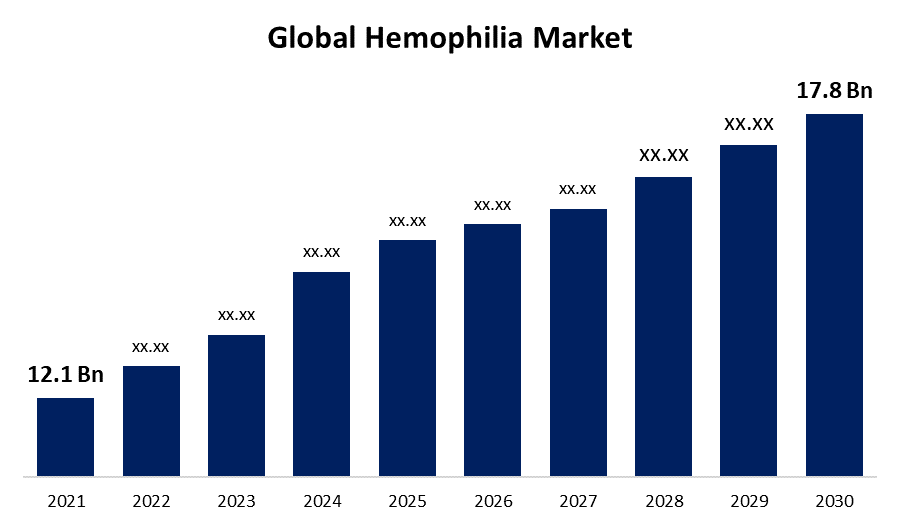Global Hemophilia Market Size To Grow USD 17.8 Billion By 2030 | CAGR of 7.55%
Category: HealthcareGlobal Hemophilia Market Size To Grow USD 17.8 Billion By 2030
According to a research report published by Spherical Insights & Consulting, The Global Hemophilia Market Size to grow from USD 12.1 billion in 2021 to USD 17.8 billion by 2030, at a Compound Annual Growth Rate (CAGR) of 7.55% during the forecast period.

Get more details on this report -
Browse key industry insights spread across 210 pages with 122 market data tables and figures & charts from the report “Global Hemophilia Market Size, Share, and COVID-19 Impact Analysis, By Treatment (On-demand, Prophylaxis), By Therapy (Immune Tolerance Induction (ITI) Therapy, Replacement Therapy, Gene Therapy), By End Use (Hospital Pharmacies, Retail Pharmacy, Others), by Region (North America, Europe, Asia-Pacific, Latin America, Middle East, and Africa), Analysis and Forecast 2021 – 2030 “ in detail along with the table of contents. https://www.sphericalinsights.com/reports/hemophilia-market
A category of bleeding disorders known as haemophilia are characterised by slow blood clotting. It primarily falls under the categories of haemophilia A and haemophilia B. The absence of clotting factor VIII or IX in the blood is the root cause of it. Hemophilia is typically handed down through families (inherited). Children that are male tend to inherit it the most. Bleeding is the hallmark sign of haemophilia. Minor cases are anticipated to go unnoticed until significant bleeding after surgery or an injury. In severe cases, bleeding happens randomly. Anywhere can have internal bleeding, and bleeding into joints is frequent. After a person experiences an unusual bleeding event, it is diagnosed. If other family members are affected, a blood test can also be used to identify the issue. The main course of treatment involves injecting blood through a vein with extra clotting factor (intravenous infusions). If you suffer from this bleeding disorder, certain precautions must be followed during surgery. Therefore, the patient's surgeon needs to be aware of this problem before performing. Sharing information about the disorder with blood relations is crucial because they might also develop the condition. The lack of therapeutic therapy choices and the increasing pressure on regulatory authorities to address it are driving up R&D activities. An organisation of people who operate in the construction sector is referred to as a "ecosystem." The market share for haemophilia therapy has increased as a result of rising haemophilia prevalence, technological advancements in haemophilia treatment, and supportive governmental initiatives for haemophilia management. The high cost of haemophilia therapy, the dearth of haemophilia treatments, and the significant side effects associated with plasma-derived products are all expected to restrain the market's growth.
The On Demand holds the largest market share over the forecast period.
On the basis of treatment, the hemophilia market is segmented into prophylaxis and on-demand treatment. Among these, the on demand holds the largest market share over the forecast period. On the other hand, propphylaxis segment is witnessing the fastest market growth over the forecast period. Prophylaxis, a well-established therapy that entails routinely giving clotting factor concentrates to those with severe haemophilia, is what is causing the condition's rise in prevalence. The length of this treatment depends on how serious the patient's condition is. Treatment for prophylaxis is anticipated to increase quality of life while lowering productivity loss.
The Replacement Therapy is dominating the market with the largest market share over the forecast period.
Based on the therapy, the hemophilia market is segmented into immune tolerance induction (ITI) therapy, replacement therapy, and gene therapy. Among these, the replacement therapy is dominating the market with the largest market share over the forecast period. The gold standard of treatment is replacement therapy, which helps patients replace their missing clotting factor. Gene therapy, which seeks out broken DNA bases and replaces them with functional ones, is one of the more recent areas. AMT-060, a potential drug developed by UniQure to treat type B, is presently undergoing clinical testing. The therapy aids patients in starting to produce factor IX once more by inserting a functioning copy of the factor IX gene into the liver cells of type B patients.
The Hospital segment is dominating the market with the largest market share over the forecast period.
On the basis of end user, the hemophilia market is segmented into hospital pharmacies, retail pharmacy, and others. Among these, the hospital segment is dominating the market with the largest market share over the forecast period. The hospital market is driven by the potential for board certification for experienced hemologists, the relevance of offering top-notch treatment programmes, and the productivity gains they bring about. To assist both patients and insurance companies, these healthcare institutions offer treatments at fair prices. Because new medications are now so easily accessible, hospitals are now more likely to treat bleeding disorders. In-depth hospital treatment planning and continuing supervision are also expected to increase patient choice for these drug healthcare facilities. This inherited bleeding disorder is resulting in a rise in hospital admissions. The demand for improved treatment is projected to encourage product uptake in these facilities.
North America is dominating the market with the largest market share over the forecast period.

Get more details on this report -
Among all other regions, the North America is dominating the market with the largest market share over the forecast period. Initial regional development drivers include rising prevalence and a rising propensity for preventative medicine, according to predictions. In the US, this condition is discovered quite early in life. On the other hand, Asia-Pacific is anticipated to see the most increase during the anticipated time. Increased per capita use of medications for factor VIII and IX insufficiency and early identification of the illnesses in countries like Japan, India, Indonesia, and Malaysia are key impact-producing variables.
Market Segment
This study forecasts revenue at global, regional, and country levels from 2021 to 2030. Spherical Insights has segmented the global Hemophilia market based on the below-mentioned segments:
Hemophilia Market, By Treatment
- On-demand
- Prophylaxis
Hemophilia Market, By Therapy
- Replacement Therapy
- ITI Therapy
- Gene Therapy
Hemophilia Market, By End User
- Hospital Pharmacy
- Retail Pharmacy
- Others
Hemophilia Market, Regional Analysis
- North America
- US
- Canada
- Mexico
- Europe
- Germany
- Uk
- France
- Italy
- Spain
- Russia
- Rest of Europe
- Asia Pacific
- China
- Japan
- India
- South Korea
- Australia
- Rest of Asia Pacific
- South America
- Brazil
- Argentina
- Rest of South America
- Middle East & Africa
- UAE
- Saudi Arabia
- Qatar
- South Africa
- Rest of Middle East & Africa
About the Spherical Insights & Consulting
Spherical Insights & Consulting is a market research and consulting firm which provides actionable market research study, quantitative forecasting and trends analysis provides forward-looking insight especially designed for decision makers and aids ROI.
Which is catering to different industry such as financial sectors, industrial sectors, government organizations, universities, non-profits and corporations. The company's mission is to work with businesses to achieve business objectives and maintain strategic improvements.
CONTACT US:
For More Information on Your Target Market, Please Contact Us Below:
Phone: +1 303 800 4326 (the U.S.)
Phone: +91 90289 24100 (APAC)
Email: inquiry@sphericalinsights.com, sales@sphericalinsights.com
Contact Us: https://www.sphericalinsights.com/contact-us
Need help to buy this report?